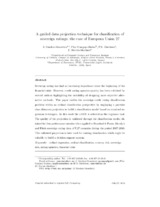Mostrar el registro sencillo del ítem
A guided data projection technique for classi cation of sovereign ratings: the case of European Union 27
| dc.contributor.author | Sánchez-Monedero, J. | |
| dc.contributor.author | Campoy-Muñoz, P. | |
| dc.contributor.author | Gutiérrez, P.A. | |
| dc.contributor.author | Hervás-Martínez, César | |
| dc.date.accessioned | 2017-01-20T12:05:29Z | |
| dc.date.available | 2017-01-20T12:05:29Z | |
| dc.date.issued | 2017-01-20 | |
| dc.identifier.uri | http://hdl.handle.net/10396/14349 | |
| dc.description.abstract | Sovereign rating has had an increasing importance since the beginning of the nancial crisis. However, credit rating agencies opacity has been criticised by several authors highlighting the suitability of designing more objective alternative methods. This paper tackles the sovereign credit rating classi cation problem within an ordinal classi cation perspective by employing a pairwise class distances projection to build a classi cation model based on standard regression techniques. In this work the -SVR is selected as the regressor tool. The quality of the projection is validated through the classi cation results obtained for four performance metrics when applied to Standard & Poors, Moody's and Fitch sovereign rating data of U27 countries during the period 2007-2010. This validated projection is later used for ranking visualization which might be suitable to build a decision support system | es_ES |
| dc.format.mimetype | application/pdf | es_ES |
| dc.language.iso | eng | es_ES |
| dc.rights | https://creativecommons.org/licenses/by-nc-nd/4.0/ | es_ES |
| dc.subject | Ordinal regression | es_ES |
| dc.subject | Ordinal classification | es_ES |
| dc.subject | Country risk | es_ES |
| dc.subject | Rating agencies | es_ES |
| dc.subject | Financial crisis | es_ES |
| dc.title | A guided data projection technique for classi cation of sovereign ratings: the case of European Union 27 | es_ES |
| dc.type | info:eu-repo/semantics/preprint | es_ES |
| dc.relation.projectID | Gobierno de España. TIN2011-22794 | es_ES |
| dc.relation.projectID | Junta de Andalucía. P2011-TIC-7508 | es_ES |
| dc.relation.projectID | Junta de Andalucía Ph.D. Student Program. | es_ES |
| dc.rights.accessRights | info:eu-repo/semantics/openAccess | es_ES |

